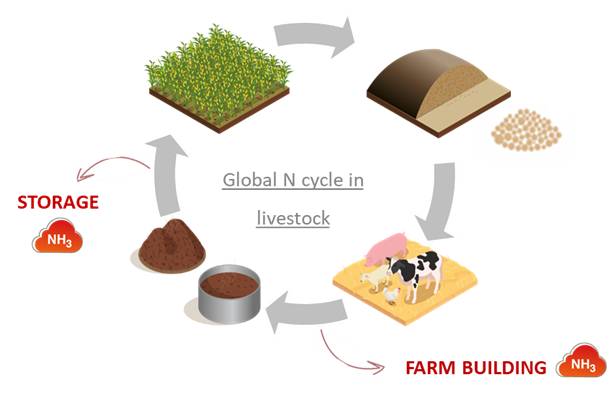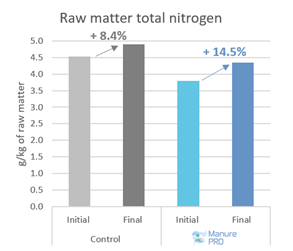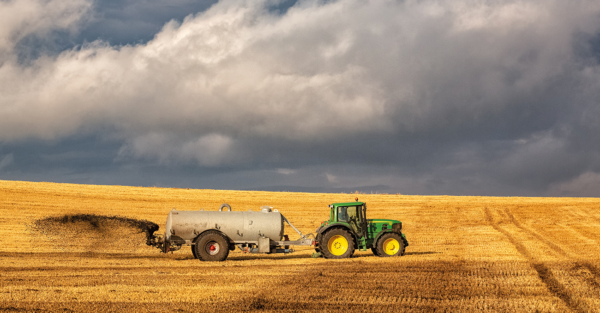Blog | Reading Time 4 minutes
Slurry inoculants help reduce ammonia emissions, cut fertilizer and labor costs
Manure and slurry are valuable fertilizing elements, providing organic matter for the soil and crops. However, management and handling — from the farm to the field — can lead to logistical and agronomic difficulties. Depending on spreading conditions, it may lead to a total loss of complete ammoniacal nitrogen, and thus a loss of fertilizing value. With an estimated 27 m3 of slurry produced per dairy cow and per year, increased efficiency in the nitrogen cycle can help farmers improve returns.
Inoculation of manure and/or slurry with selected beneficial bacteria and enzymes is becoming a well-documented way to improve return on investment through nitrogen retention and reduce workload for farmers.
Challenges of slurry management
Slurry refers to all animal waste (urine and feces), feed residues, bedding material, as well as other liquid waste from the farm, such as milking parlor wash water and rainwater.
Ammonium N (NH4+) contained in slurry can be converted into gaseous ammonia (NH3) and released into the atmosphere. The main impacts of NH3 volatilization are:
- Environmental impacts to air quality. The EU has set objectives of 19% reduction of global ammonia emissions by 2030. Each EU member state is setting local policies and techniques to reach this goal.
- Productivity losses to fertilizing value, which lead to a negative economic impact. Slurry is a resource livestock producers have readily available. Today’s N prices are dramatically high, making it paramount to keep the slurry nutritional value for crops to reduce the need for purchased inputs (Figure 1).
Slurry quality and its nutritional value for the crop can be enhanced through good management. Among the management practices, the use of microbiological slurry treatments has been highlighted as a valuable option to maintain nitrogen value.

Figure 1: Representation of the overall nitrogen cycle in livestock and potential loss of nitrogen when manure/clurry management is suboptimal.
Slurry inoculant: How does it work?
The idea behind slurry inoculants is quite similar to the concept of silage inoculants. By inoculating the raw material (slurry or forage) with specifically chosen bacteria from the start (the inoculant), it is possible to orientate their microbial ecosystems and, thus, their fermentation profiles in time.
An inoculant, MANURE PRO, has been developed by microbiology pioneer Lallemand Animal Nutrition. It is a highly concentrated combination of live lactic acid bacteria (LAB) and Bacillus strains with lignocellulolytic enzymes that help improve fiber fermentation during slurry storage. This provides a nutrient source to the microbes in the inoculant, which gives them a competitive edge. These positive fermentations help the bacteria retain nitrogen.
The application of MANURE PRO on slurry can therefore have a positive impact on nitrogen retention by up to 20%, depending on the slurry’s initial composition, reducing the farm dependency on N fertilizer.
On-farm benefits
One pit was innoculated with MANURE PRO while another one was used as control. It is important to compare two pits simultaneously given the value of the slurry at the start may be different. Indeed, this was the case in this trial. This is why the trial compared the evolution of nitrogen retention in organic matter and not the absolute value (Figure 2). This trial showed the pits inoculated with MANURE PRO show better nitrogen retention in the slurry vs. control pits.

Figure 2: Evolution of slurry nitrogen retention (nitrogen content in raw matter vs. ammoniac) in control and MANURE PRO pits (Lallemand Animal Nutrition internal data. 2021. Commercial farm, Netherlands).
When looking at the fertilizing value of the slurry — and taking into account the cost of the inoculant — the gain is significant for the farmer: + 1,433€/year for 100 cows, when considering N costs of 3 €/Kg. However, this is not the only benefit to the farmer. With the correct application of the slurry inoculant, the consistency and handleability of slurry are improved (thinner crust), which will reduce the fuel and labor costs associated with slurry management.
Conclusion
Recent trial results indicate that using a specific enzymatic and bacterial inoculant on slurry can contribute to achieving ambitious EU goals for reducing NH3. In addition, making the best use of the nutrients in slurry can cut the amount of purchased fertilizer needed, providing a crucial opportunity to improve the bottom line as input costs continue to squeeze farm margins.
To learn more about MANURE PRO, click here!
Published Mar 13, 2023 | Updated Jun 13, 2023
Related articles
Need specific information?
Talk to an expert


